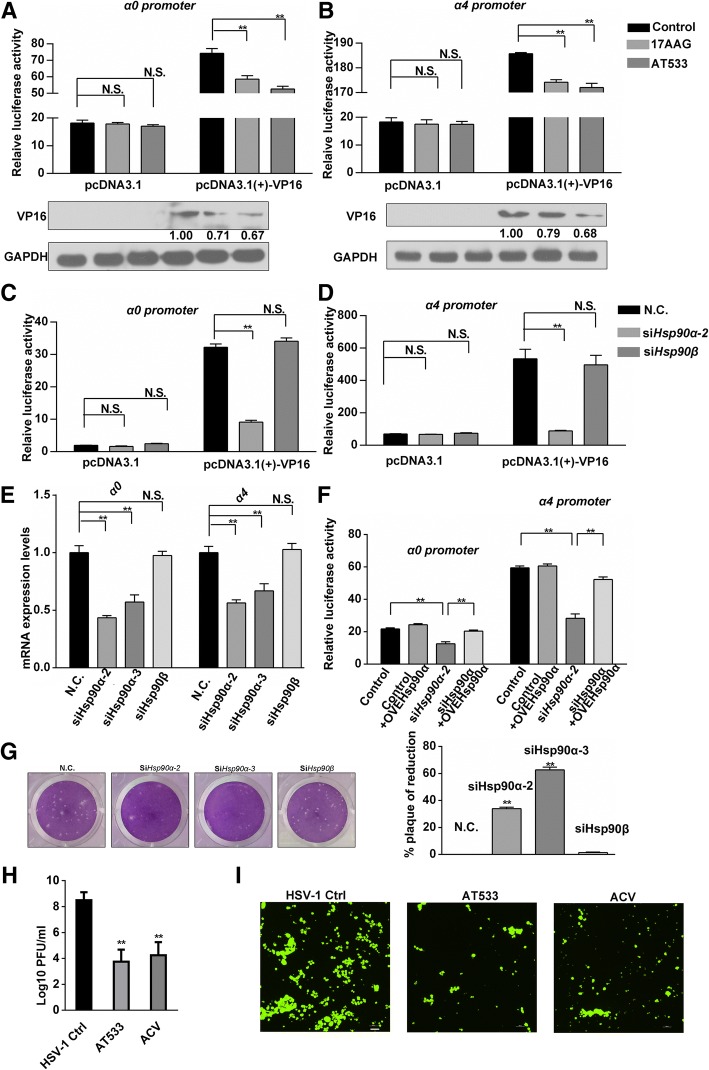Fig. 1.
Hsp90α is involved in modulating the transcription of HSV-1 α genes. a, b The promoter activity of HSV-1 α genes in the presence of Hsp90 inhibitors. Vero cells were cotransfected with reporter plasmids as described in section 2.4 of the Materials and Methods. Cells were then treated with 17AAG (0.5 μM) or AT533 (2 μM) for 2 h. Cell lysates were subjected to luciferase activity assays (a and b, upper) and analyzed by western blotting to detect VP16 overexpression efficiency (A and B, lower). Bar graph represents the result of DLRs from 3 independent experiments expressed as means ± SEM; (c, d) The promoter activity of α0 and α4 in the context of Hsp90α or Hsp90β downregulation. Vero cells were transfected with reporter plasmids together with siHsp90α or siHsp90β (100 nM) as indicated for as described in section 2.4 of the Materials and Methods. Cell lysates were then harvested to test luciferase activity. Bar graph represents the result of DLRs from 3 independent experiments expressed as means ± SEM; (e) Effects of Hsp90α or Hsp90β knockdown on the RNA levels of α0 and α4. Vero cells were transfected with siHsp90α-2, siHsp90α-3, and siHsp90β (100 nM) for 24 h and then infected with HSV-1 (MOI 50). Total RNA was extracted at 2 hpi and then subjected to the analysis of RNA levels of α0 and α4 using qRT-PCR. f Hsp90α restored the suppressed promoter activity of α0 and α4 genes induced by Hsp90α knockdown. Vero cells were cotransfected with siHsp90α-2 (100 nM) and the indicated luciferase reporter plasmids as described in section 2.4 of the Materials and Methods. The cell lysates were subjected to luciferase activity assays. Bar graph represents the result of DLRs from three independent experiments expressed as means ± SEM; (g) Plaque formation assays showing that HSV-1 infection was affected by Hsp90α knockdown. Cells were infected with HSV-1 for 2 h after transfecting siHsp90α or siHsp90β (100 nM) knockdown and then subjected to plaque assays (left). Quantitative histograms were prepared (right). h Virus yield assay in the context of Hsp90 knockdown and Hsp90 inhibition. Cells were infected with HSV-1(MOI 1) for 24 h after transfecting siHsp90α (100 nM) and then subjected to determine the yield of virus; the group of acyclovir was also included as a control. i Hsp90 inhibition reduced the fluorescenceintensity of GFP-HSV-1 infected SH-SY5Y cells; SH-SY5Y cells were infected with GFP-HSV-1 (MOI 1) for 24 h in the presence of 17AAG (0.5 μM) or AT533 (2 μM). The cells were observed with fluorescence microscope. Scale bars, 200 μm

